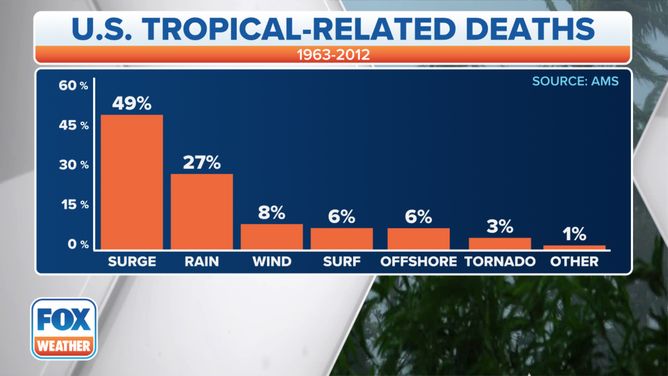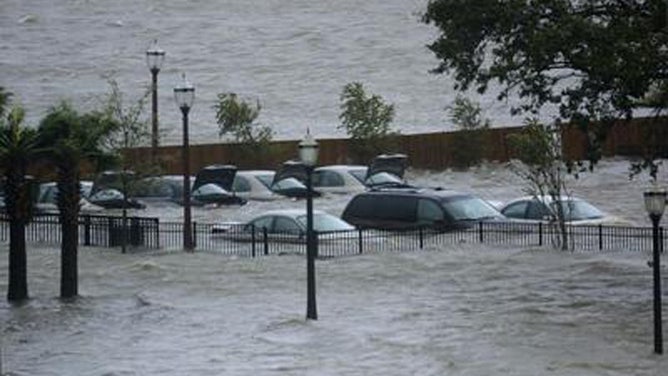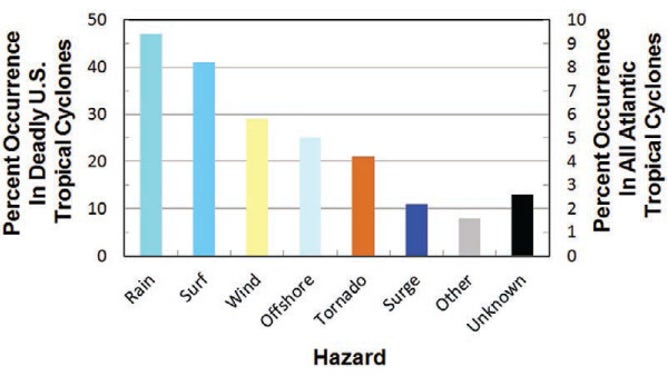Storm surge from hurricanes, tropical storms kills more in US than wind
Storm surge is responsible for nearly half of the fatalities from tropical cyclones that strike the US.
Water from hurricanes, tropical storms kills more in US than wind
Water is the No. 1 killer during a hurricane or tropical storm that strikes the U.S. – comprising nearly 90% of all tropical cyclone deaths.
Hurricanes may only be rated by their sustained wind on the Saffir-Simpson Hurricane Wind Scale, but it’s important not to overlook the power of water when a tropical cyclone is bearing down on the U.S.
Water is the No. 1 killer during a hurricane or tropical storm that strikes the U.S. – comprising nearly 90% of all tropical cyclone deaths – mostly by drowning in either storm surge, rainfall flooding or high surf, according to a 2014 study by Dr. Edward Rappaport, deputy director of the National Hurricane Center.
During Rappaport’s 1963-2012 period of study, storm-surge flooding claimed nearly half of the fatalities (49%), rainfall-induced freshwater floods and mudslides accounted for about one-quarter of the deaths (27%), high surf was responsible for some 6% of all hurricane deaths and another 6% occurred offshore in marine incidents within 50 nautical miles of the coast.
HOW TO WATCH FOX WEATHER ON TV

Cause of death in the U.S. directly attributable to Atlantic tropical cyclones between 1963-2012. (Data: Edward N. Rappaport, National Hurricane Center)
(FOX Weather)
Rappaport found that only 8% of hurricane- or tropical-storm-related fatalities were from wind, while any embedded tornadoes produced by the storm were blamed for another 3% of the deaths.
The data from the 50-year period of study of 650 to 700 Atlantic tropical cyclones showed that two to three per year turned deadly in the U.S. Only three of the 10 deadliest tropical cyclones between 1963-2012 were major hurricanes (Category 3 or higher) when making landfall, and six of those 10 were just tropical storms or Category 1 hurricanes when they came ashore, so it’s very important to take every tropical storm seriously, no matter its hurricane category and rating on the Saffir-Simpson Hurricane Wind Scale.
HOW ARE HURRICANES RATED? THE SAFFIR-SIMPSON HURRICANE WIND SCALE EXPLAINED
Storm surge poses the greatest threat to human life
Rappaport’s study concluded that 49% – nearly half – of all fatalities from U.S. hurricanes and tropical storms were blamed on storm-surge flooding.
NOAA’s National Ocean Service defines storm surge as the abnormal rise in water levels during a storm surge, measured as the height of the water above the normal predicted astronomical tide.
"The surge is caused primarily by a storm’s winds pushing water onshore," the NOS said. "The amplitude of the storm surge at any given location depends on the orientation of the coastline with the storm track; the intensity, size and speed of the storm; and the local bathymetry." (Bathymetry is basically the underwater equivalent of topography.)
TROPICAL DEPRESSION VS. TROPICAL STORM VS. HURRICANE: WHAT'S THE DIFFERENCE?
The NHC’s final report on Hurricane Katrina from 2005 estimated a 24- to 28-foot storm surge along the Mississippi ocean coast across a swath about 20 miles wide, centered around St. Louis Bay, while a 15- to 19-foot surge was estimated in eastern parts of New Orleans and St. Bernard and Plaquemines parishes in Louisiana.
Katrina was responsible for 1,833 fatalities, of which 1,577 were in Louisiana alone, according to the NHC. Most of the deaths in Louisiana were directly caused by the widespread storm-surge flooding and its aftermath in the New Orleans area, the NHC said.

The trunks of cars parked in a parking lot next to the GM&O building in downtown Mobile, Alabama, open when they are surrounded by water caused by the storm surge from Hurricane Katrina Monday, Aug. 29, 2005.
(Shared by the NWS office in Mobile, Alabama)
The NHC publishes potential storm-surge inundation maps during any tropical depression, tropical storm, or hurricane that poses a risk to the coastline to clearly illustrate the potential threat from this highly dangerous hazard associated with a landfalling storm.
Prior to a tropical cyclone threatening your home, you should find out if you live in an evacuation zone or where you can find safety. If you do, be sure to follow all evacuation orders from your local emergency managers because it may end up saving your life.
HOW TO PREPARE FOR AN EVACUATION
Rainfall flooding is the most frequent cause of death
Drowning from excessive rainfall was the most frequent cause of death from U.S. hurricanes and tropical storms in the 50-year Rappaport study. Nearly half of the tropical cyclones that turned deadly between 1963-2012 had a death that was caused by flooding from heavy rain.

Percentage of 1963-2012 Atlantic tropical cyclones (right scale) and deadly U.S. tropical cyclones (left scale) in which noted types of fatalities occurred in the United States.
(Edward N. Rappaport, National Hurricane Center)
Rappaport noted that tropical cyclone rainfall events often take place far from the storm’s center of circulation, sometimes persisting long after the storm has significantly weakened or even dissipated as a tropical cyclone.
Additionally, historic flooding can result if a storm moves very slowly or stalls over the same area for a prolonged period of time. This can occur even if it’s only a tropical depression or tropical storm since a storm’s rainfall potential is dictated only by its forward speed, not its maximum winds.
In 2018, Hurricane Florence set a new tropical cyclone rainfall record for North Carolina with 35.93 inches and South Carolina with 23.63 inches because of its extremely sluggish forward movement, resulting in disastrous flooding in both states. Florence was responsible for 22 direct deaths in the U.S., of which 17 were caused by freshwater flooding (four from wind and one from a tornado associated with the storm).
HURRICANE HARVEY: BY THE NUMBERS
Hurricane Harvey in 2017 is another recent example of this. More than 60 inches of rain inundated parts of southeastern Texas after the storm stalled over the region for days, resulting in at least 68 fatalities, all but three of which were from freshwater flooding.
